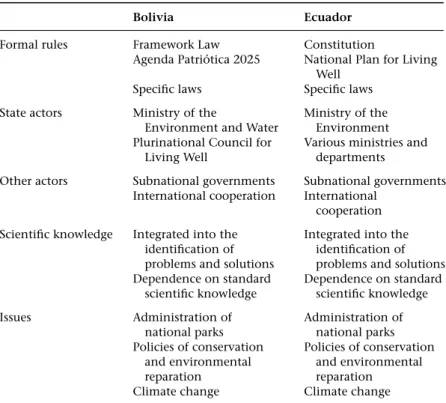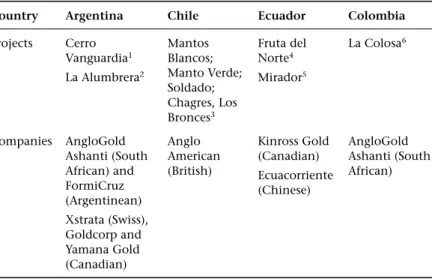It can lead to a concentration of economic and political power in the hands of the elite. The capture of the state by the Revolutionary Nationalist Movement (Movimiento Nacionalista Revolucionario (MNR)) and the Bolivian Workers' Union (Central Obrera Boliviana (COB)) in 1952 led to the nationalization of the mines in October of that year and the formation of the state-owned Mining Corporation of Bolivia (Corporación Minera de Bolivia (COMIBOL)) (Paredes, 2012). In an effort to attract private transnational companies, state participation – in the form of royalties – was reduced in favor of the creation of income taxes.
This led to the breakout of the GANA party (Gran Alianza por la Unidad Nacional) shortly after the Funes government took power. This led to the weakening of the environmentalist faction of the government and to the emergence and gradual strengthening of a young technocratic elite. This contributed to a weakening of the influence of the old rural elite (Zenteno Hopp, Hanche-Olsen and Sejenovich, 2015).
Mining, gas and oil extraction are the most important activities to generate economic income for most countries in the Amazon basin. 2002) Environmentalism of the Poor: A Study of Ecological Conflicts and Valuation (Cheltenham: Edward Elgar Publishers). In the reference cases studied, the importance of water consumption and mining is a topic of a "high level" and experts.
References to water and energy consumption in the mining and environmental legislation of the countries studied are also scarce (OCMAL, 2012).

Indispensable but responsible mining with maximum efficiency
Despite a common terminology, social representations of the environment and climate change, technology, the human-nature relationship and development models point to divergent positions. The interviews of strategic actors reveal important discourse structures that can be classified into four models that express specific views on the consumption of water and energy in mining. The goal of our analysis was to discover the elementary structures of meaning in the discourses, followed by a linguistic and extralinguistic (social, political, cultural) interpretation of the discourse.
This discourse model seeks forms of efficient consumption of water and energy in mining through its rational and balanced use. It is claimed that the use of water in mining is significantly less than in other activities due to the pipeline effect: large amounts of water are manipulated, but little is consumed; recycling is very common. In other areas where water is consumed (agriculture), most of the water continues to evaporate. 12.
In particular, Chilean and Colombian interviewees problematize the issue of energy, while interviewees from Argentina and Ecuador tend to have a more optimistic perspective. The premise is that metal mining is recognized as intensive in terms of energy use, mainly from fossil fuels or hydroelectricity. If mining consumes energy, the price of energy must take into account the environmental impacts of generating that energy.
What is stronger and more problematic in mining is electricity, this issue is very critical. Chilean senior official in the mining industry) Various projects. canceled due to high energy costs. Chilean senior executive of a multinational mining company) Furthermore, this model fits into a neoliberal conceptual framework that places greater importance on the market than on the state.
The market (must fix), we all love the market. Argentinian senior executive of a transnational mining company) Assuming that mining requires significant energy for its processes, facilities and transportation, this discourse model accepts that most energy comes from fossil fuels.
Integrated management, regulation and responsible consumption
In this discourse model, the issue of energy is commodified: it is necessary for markets to function competitively. This discourse model proposes responsible mining that manages to establish a balance between the pursuit of profitability, the environment and social needs: in other words, a legal corporate mining activity. Therefore he proposes "rational use of resources", "responsible mining". the local population had nothing to do in San Juan, but now there is mining that increases other activities.17.
Argentinian expert and consultant on environmental issues) Water and energy consumption is represented by a semantic axis of efficiency/inefficiency, where "efficient practice" opposes "inefficient consumption". It is the responsibility of the companies as well as the authorities how the projects are developed, managed and implemented. 19. Argentinian expert and environmental consultant) Regarding water. good mining is technically realized, economically profitable and it ensures the fair participation of the Ecuadorian state, a socially responsible mining and mining that is managed environmentally with strict standards.20.
This discourse model favors regulation through, among other things, "price mechanisms", which stipulate mixed policies to enable the proper functioning of the market and forms of state regulation (environmental assessment, laws and norms, effective fiscalization). The model proposes the establishment of clear energy policies that determine energy consumption in mining. The incentives are well placed when the decision maker has - to the greatest extent possible - internalized all the potential (environmental) costs that energy use represents. 21. Chilean senior official and former minister of state) Regulation requires planning, evaluation and control of mining activities.
In this discourse model, there are some views and positions that are critical of the rationale of those who want to grow at any cost. This is not necessarily linked to a vision of integrated, efficient and responsible management of water and energy. In summary, this model generates a clear sense of the consumption of water and energy in mining with explicit central concepts, such as efficiency, recycling, integrated management and responsible consumption.
The second focus is on creating the institutions and conditions that allow for better regulation and establishing certain regulations that guarantee private investment and frame the responsible use of water and energy in mining.
Sustainable development and institutional control
The incentives are well placed when the decision-maker has internalized – to the greatest extent possible – all the potential (environmental) costs that energy consumption represents. 21. From this perspective, communities must be prevented from deepening their opposition to mining projects and hindering the functioning of institutions and regulations. A clear policy involving "integrated regulation" is fundamental for "legal certainty" to exist and encourage mining investment.
For example, one international expert acknowledges that this is not necessarily a consistent practice for large mines where emphasis is placed on the general discourse on CSR. This is the reason for the need for efficiency and recycling in water and energy consumption and – given the environmental crisis – the need for environmental controls that guarantee sustainable mining. In case of water. it must be resolved through strict control of available resources.23.
Chilean politician, representative of the centre-left). it should, as I said, be with the least environmental impact.24. Regarding energy, the basic semantic axis lies in the contrast between "carbon energy" and "renewable energy". the energy grid is far too carbonated.25. For that reason, the president has decided to change the energy grid, for example from thermoelectric to hydropower.
In summary, this model is based on a policy proposal of sustainable development which criticizes the environmental impact of mining, but which includes mining as a factor of development. It subjects mining to control, rules and regulations and seeks to promote sustainable use of water and energy by promoting efficiency, recycling and a transition to renewable energy, including this transition within the mining sector itself. It proposes sustainable development with the state's clear intervention to ensure a market with clear and competitive rules.
In short, water and energy consumption is seen as a political problem and not just one of technical management.
Alternative development for the protection of common goods
Perceptions of intergenerational and long-term environmental impacts are present in this discourse model. It is a critical look at the current development model and public policies, including those of "progressive" governments. The consumption of water and energy in mining, seen in the light of the analyzed discourses, is not an exclusively technical subject.
From a socio-technical and socio-political point of view, we extended this to the concept of a water-energy-mining complex. This means that it has the potential to improve its production activities to meet the needs of the population. The latter could be a greater goal – striving for the comprehensive development of the population.
Another example of the contradiction between nature and society can be found in the soybean industry in Argentina. Concentrated in the Pampas region, the core of the country's most fertile land, it is another example of oligopolistic accumulation of natural resources. It also includes potential benefits in terms of nutrition and food diversity.
Subsequently, it experienced a second contamination by new industries, affecting the health of the population (ACUMAR, 2007). This case was known as the “Mendoza case” and was based on the execution of court orders to restore the watershed and improve the quality of life of the population. The right to livelihood is met through decontamination to improve the health of the population.
A greater participation process was also observed in the advisory body of the ACUMAR, which includes universities and NGOs. The organizational forms of the state and its operations should be reoriented to better achieve sustainable development (Kliksberg, 2014). We must bear in mind that Latin America owns almost half of the world's tropical forests.
New Projects of Environmental Governance

